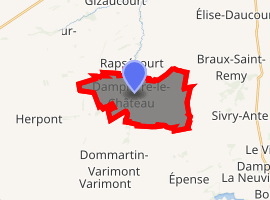Dampierre-le-Château
Dampierre-le-Château (French pronunciation: [dɑ̃pjɛʁləʃɑto]) is a commune of the Marne department in the Grand Est region of France. It is located on the Yèvre river.
Dampierre-le-Château | |
|---|---|
 The town hall in Dampierre-le-Château | |
Location of Dampierre-le-Château 
| |
 Dampierre-le-Château  Dampierre-le-Château | |
| Coordinates: 49°00′37″N 4°47′47″E | |
| Country | France |
| Region | Grand Est |
| Department | Marne |
| Arrondissement | Châlons-en-Champagne |
| Canton | Argonne Suippe et Vesle |
| Intercommunality | Communauté de communes de la Région de Givry en Argonne |
| Government | |
| • Mayor (2008–2014) | Jean-Marie Viriot |
| Area 1 | 11.13 km2 (4.30 sq mi) |
| Population (2017-01-01)[1] | 106 |
| • Density | 9.5/km2 (25/sq mi) |
| Time zone | UTC+01:00 (CET) |
| • Summer (DST) | UTC+02:00 (CEST) |
| INSEE/Postal code | 51206 /51330 |
| 1 French Land Register data, which excludes lakes, ponds, glaciers > 1 km2 (0.386 sq mi or 247 acres) and river estuaries. | |
History

Monument aux Morts and church
Before the French Revolution, it was called "Dampierre-en-Astenois". It was renamed "Dampierre-sur-Yèvre" in 1793, and eventually "Dampierre-le-Château" in 1801.

The Yèvre at Dampierre-le-Château
gollark: Just use PotatOS Autopotatocraft©©©©.
gollark: Portals and magic item vacuum thingies.
gollark: With 6 it goes down to, what, 30 seconds?
gollark: The paint and stuff cover up the glow.
gollark: Gunpowder is glowstone painted gray.
See also
References
- "Populations légales 2017". INSEE. Retrieved 6 January 2020.
| Wikimedia Commons has media related to Dampierre-le-Château. |
This article is issued from Wikipedia. The text is licensed under Creative Commons - Attribution - Sharealike. Additional terms may apply for the media files.